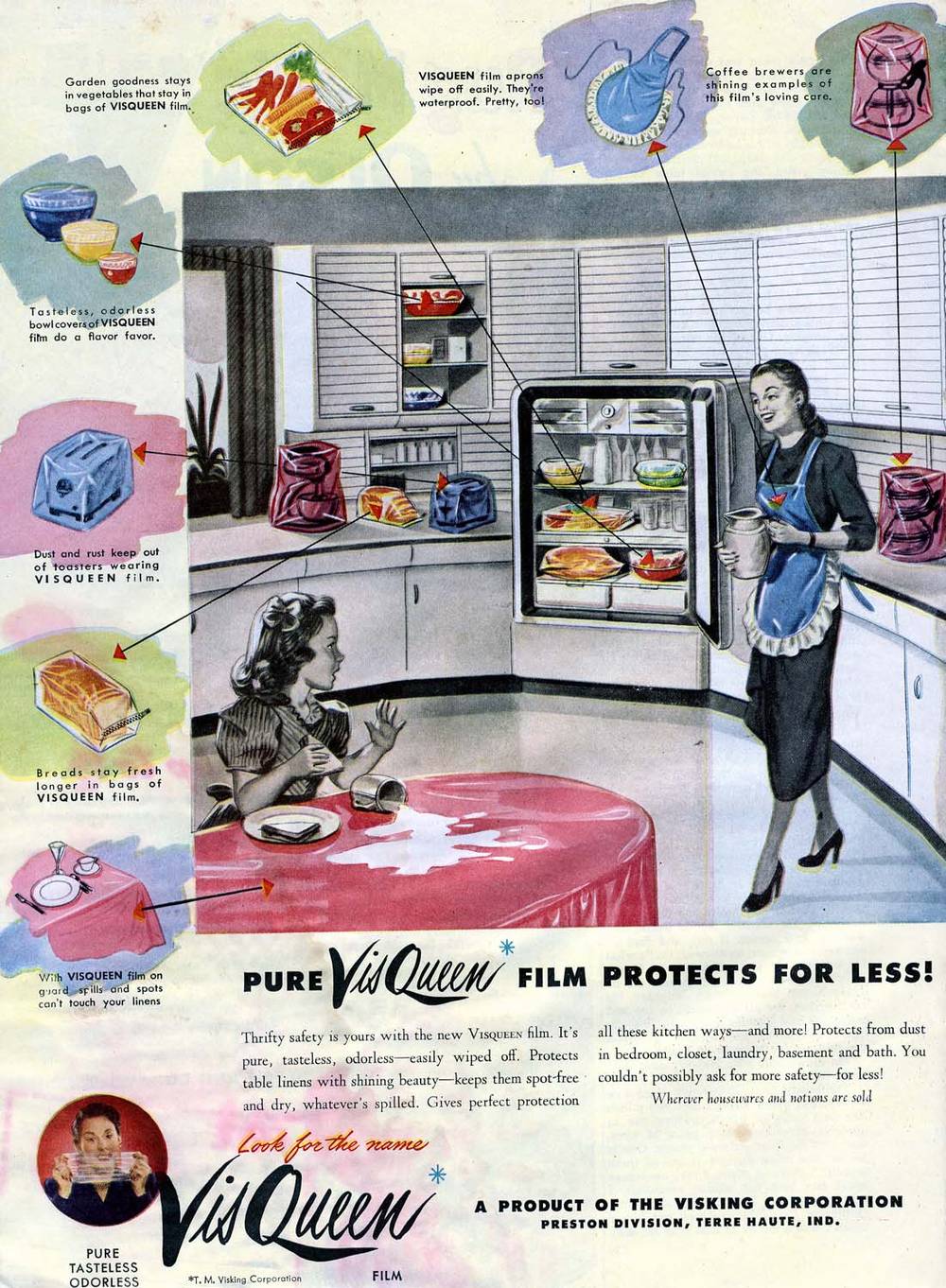
This 1948 ad for Viking's "VisQueen" plastic film paints a utopian vision of a world where everything is entombed in airtight plastic layers, rendering it sterile and impervious to the world's depredations and imperfections. My grandmother practiced this sort of mummification in her living room and most of the kitchen until all her grandchildren were well past adolescence.
Search This Blog
Friday, February 10, 2012
World wrapped in plastic: 1948 cling-film ad
Interactive "Starry Night" adds a touch of movement
Petros Vrellis created this interactive, animated version of Vincent Van Gogh's Starry Night, where the viewer can send impressions swirling with a touch. [Creative Applications] Previously.
Chased By the Light

Chased by the Light
This project is a zen masterpiece. It is also a behavior-modifiying challenge for all digital photographers: Look instead of click.
In the 1990s veteran magazine photographer Jim Brandenbrug gave himself an impossible assignment: "For 90 days between the autumn equinox and winter solstice I would make only one photograph a day. There would be no second exposure, no second chance." A single exposure, a single click per day! He was using film, and he was photographing wildlife, including elusive animals in the north woods in upper Minnesota. Film is unforgiving. For amateur and professional alike getting even an acceptable photo in these conditions with one shot requires relying on the Force. Yet Brandenburg found, or made, one beauty after another. Most mortals would need a hundred shots to get one like these. The 90 images stand strong each on their own, but the complete symphony is one of the most impressive acts of mindfulness I’ve seen.
(The full set of images were also published in a smaller format in the November 1997 issue of National Geographic.)
Besides the book, there is now an iPad app.
-- KK
Chased by the Light
Jim Brandenburg
1998, 104 pages
$35
Available from Amazon
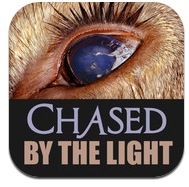
App $10
Sample Excerpts
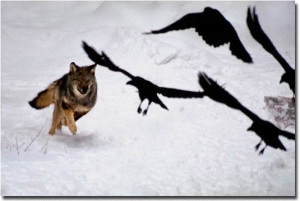
I sensed there would be lessons learned. There were, but not always those I had imagined. Some were merely lessons remembered, recapturing things I had forgotten, such as remaining open to chance, and that, in nature, not all beauty is giant in scale. One such lesson occurred on October 15th, the twenty-third day. It was late and I despaired of capturing anything of value. The day was dark and gloomy; my mood reflected the weather. I wandered through the dripping forest all day long. Tired, hungry , and wet, I was near tears. I was mentally beating myself for having passed up several deer portraits and the chance to photograph a playful otter. None of those scenes spoke to me at the time.
But perhaps because I was patient, and perhaps because, as natives do on a vision quest, I had reached my physical limits, I became open to the possibility revealed by a single red maple leaf floating on a dark-water pond. My spirits rose the instant I saw it, and although the day was very late and what little light there had been was fleeing rapidly, I studied the scene from every angle. Finally, unsure of my choice, I made the shot anyway, thankful at least that the long day had ended. Once more I was surprised by the result. The image seems to have a lyrical quality, with a rhythm in the long grass.

Thursday, February 9, 2012
Sarriugarte and Mate's Serpent Twins snake vehicles
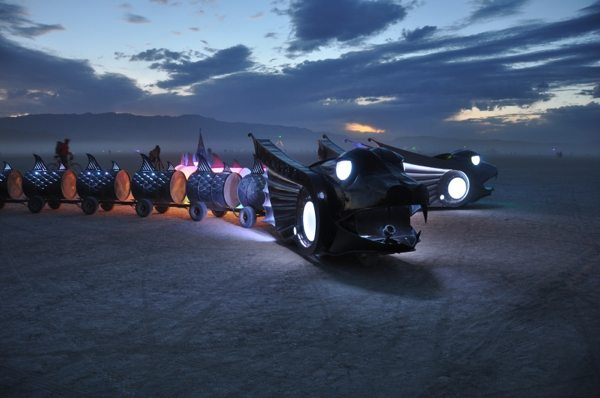
Above is video of the incredible Serpent Twins, two slithering vehicles created by the incredibly talented maker couple Jon Sarriugarte and Kyrsten Mate. You may recall that Jon and Kyrsten are the creators of such exquisite biomechanical transports as the Golden Mean snail car that I wrote about in MAKE here and the zippy Electrobyte trilobite car. The Serpent Twins are in the running for the Boca Bearings 2012 Innovation Competition grand prize of $10,000 that will be awarded to the best "innovative mechanical project that utilizes ball bearings, roller bearings, linear bearings or any form of full ceramic or ceramic hybrid bearings anywhere in the application." Jon and Kyrsten say that if they win they'll use the prize money to "buy a stacker trailer to transport our beasts to events like Maker Faire, schools, and festivals to inspire the next generation of artists, engineers and makers." All I can say is that they have my vote.
Wednesday, February 8, 2012
Zigzag bookcase shows Ikea a thing or two about not shipping air
Zigzag bookcase shows Ikea a thing or two about not shipping air

"REK is a bookcase that grows with your book collection," writes Reinier De Jong Design on its official website. "The more books the bigger the bookcase gets. The zigzag shaped parts slide in and out to accomodate books in the resulting voids. REK will always be full, regardless of the quantity of books. Also the books can be arranged according to their sizes. The narrow spaces are excellent for magazines."
Price is "on request", unfortunately, which suggests I'll be sticking with my cheapo Billies for the time being.
REK bookcase [via Jessamyn West]
Mark Jenkins's public sculptures of mannequins in distress

Sculptor Mark Jenkins's "City" series is comprised of lifelike mannequins placed in public spaces in odd postures, often in seeming distress or danger, usually with a broadly humorous undertone. They're pretty funny stuff. Shown here: "Barcelona Trashgirl."
City
(via kikirikipics)
English plainclothes police officer follows himself for 20 minutes
An undercover police officer in Sussex, England, shadowed a suspicious character through the streets a small market town for 20 minutes, following directions passed to him by a CCTV operator who guided him towards the suspect. After 20 minutes, the CCTV operator realized that the "suspicious character" was the police officer himself.
The operator directed the officer, who was on foot patrol, as he followed the "suspect" on camera last month, telling his colleague on the ground that he was "hot on his heels".
The officer spent around 20 minutes giving chase before a sergeant came into the CCTV control room, recognised the “suspect” and laughed hysterically at the mistake...
"The CCTV operator soon had the suspect on camera and everywhere he saw the male the keen PC was on his heels – radioing in to say he was in the same street...”
He added: "Every time the man darted in to another side alleyway, the PC was turning immediately into the same alleyway, but every time the CCTV operator asked what he could see there was no trace."
CCTV police officer 'chased himself' after being mistaken for burglar
(via Neatorama)
Tuesday, February 7, 2012
Mexican Banda bandits blamed for school tuba thievery
"I've robbed the rainbow to make you gay"
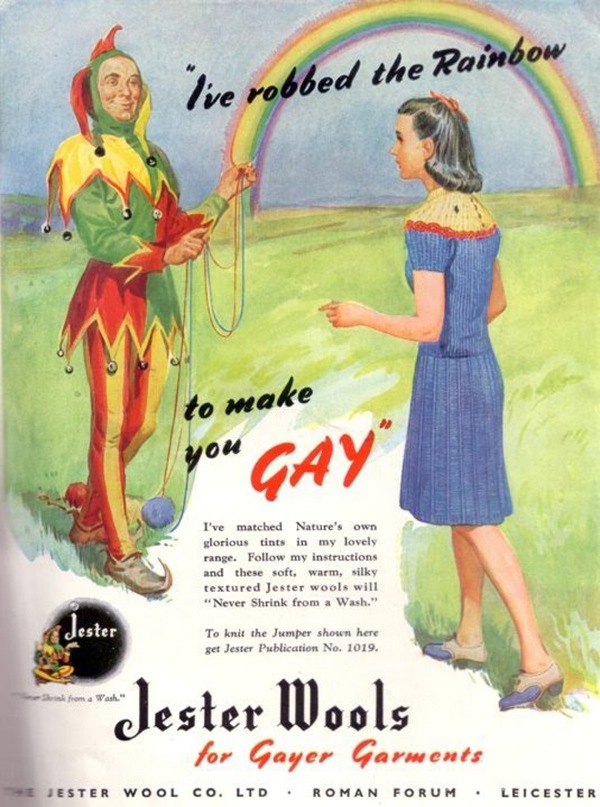
If Rick Santorum can apprehend the rainbow robber, all his problems will be solved.
Video: OK Go's "Needing/Getting"
Here is OK Go's excellent video for "Needing/Getting." And yes, it was done "in partnership" with the maker of that particular car. According to the video description, the car "was outfitted with retractable pneumatic arms designed to play the instruments, and the band recorded this version of Needing/Getting, singing as they played the instrument array with the car… There are no ringers or stand-ins; Damian took stunt driving lessons. Each piano had the lowest octaves tuned to the same note so that they'd play the right note no matter where they were struck."
Ian Bogost: the sarcastic game dev and academic who gave us Cow Clicker
In Wired, Jason Tanz tells the bizarre, incredible tale of how Ian Bogost's satirical Facebook game "Cow Clicker" became an actual, successful game, despite being designed to show how incredibly stupid and pointless the FarmVille-style Facebook games of the day were. Cow Clicker stripped the FarmVille model to its barest bones: it presented you with a picture of a cow that you could click at fixed intervals. Your friends could also click the cow. You could buy fake money ("moola") and spend it to get extra clicks. Every click generated a Facebook update: "I'm clicking a cow." Those with the most-clicked cows appeared on a leaderboard.
Cow Clicker became a top-rated Facebook game, with tens of thousands of players.
The Cow Clicker description appears in a longer article about Bogost's provocative and curious career as a games academic and designer, which has seen him design games intended to simulate the boredom of staffing TSA checkpoints; sticking to a diet; working a hateful counter-service job at Kinko's, and growing produce faster than e. coli can contaminate it.
Bogost considers A Slow Year to be one of his most important works. And yet, in the months leading up to its publication, he found himself drawn to its evil twin, Cow Clicker. Initially, Bogost planned to launch Cow Clicker and let the game run its course. But now that people were actually playing it, he felt an obligation to sustain the experience. When his server melted under the unexpected demand, he was besieged by complaints until he signed up for a cloud-computing service to handle the load. Social-game developers, many of whom saw the game as good-natured ribbing, suggested ways to improve it: Let players earn mooney by clicking one another’s newsfeed updates, for instance, which would further encourage them to spam their friends. Bogost added the feature, which he called “click on your clicks.” He also added transparently stupid prizes—bronze, silver, and golden udders and cowbells—that people could win only by amassing an outlandish number of points. (A golden cowbell, for instance, requires 100,000 clicks.)
On one level, this was all part of the act. Bogost was inhabiting the persona of a manipulative game designer, and therefore it made sense to pull every dirty trick he could to make the game as sticky and addictive as possible. But as he grew into the role, he got a genuine thrill from his creation’s popularity. Instead of addressing a few hundred participants at a conference, he was sharing his perspective with tens of thousands of players, many of whom checked in several times a day. Furthermore, every time he made the game better, he received some positive bit of feedback—more players, a nice review, a funny comment on his Facebook page. Tweaking the game was almost like a game itself: Finish a task, receive a reward.
The Curse of Cow Clicker: How a Cheeky Satire Became a Videogame Hit
(via JWZ)
